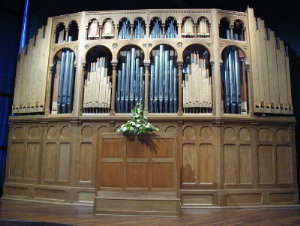 The ancient organ of the Hecht Museum Auditorium
The ancient organ of the Hecht Museum Auditorium
In 1992, about a year before Dr. Reuven Hecht's passing, Gideon Shamir (organist and musician) proposed to finance the construction of a large and unique flute organ composed of ancient organ pieces that were dismantled years ago and stored in the basements of the Franciscan Church in the Old City of Jerusalem. Dr. Hecht first led a long process of material selection, design, and design of the instrument and finally its construction, courtesy of the Hecht Foundation, in 1999. Dr. Hecht was given a model of the organ, and received a detailed briefing on the instrument's unique musical components, but building The organ lasted for over six years, so he couldn't listen to his sounds.
The ancient organ, which was installed in the Hecht Museum Auditorium, is integrated into concerts, music festivals and sometimes even conferences and seminars. Over the past twenty years, several new organists have been built in the country, but the organ in the museum's auditorium is one of the largest among them.
The characteristics of the organ
The length of the organ front is about seven and a half meters and about five meters high. The total weight of the organ is about eight tons. The organ has 1706 flutes, between three meters and a few centimeters.
Over the past twenty years, several new organists have been built in the churches in Israel, but only three of them are larger than the organ in the Hecht Museum auditorium.
The flute organ in the Hecht Museum Auditorium has 33 sound systems (registers). These are controlled by two keyboards, hand-played (manual), and by pedal keyboard, foot-play (pedal). The Manuel's range includes 58 sounds and the Pedal range includes 32 sounds. The sound material that makes up the organ is of great historical-musical value because the flute columns originally belonged to ancient organists.
The organ represents three schools of organ building art, which make up the three divisions of the organ:
The first keyboard is built around the main brigade of a fine English organ, built in 1904 for St. George's Cathedral in Jerusalem. From the English organ, the original stand and seven original columns of flutes were preserved. These were inlaid on the first keyboard, with the addition of three registers: trumpet (ancient Italian organ), deep bass flutes (ancient German organ) and texture (new from the Netherlands).
The top keyboard belongs to the Supplemental Brigade, which is based on a 1868 original Montia flutes booth, and bears the signature organ of the well-known organ of the Tsani. Only flutes were left in this wing, and all the flutes' columns had to be reconstructed to fit the Venetian tradition and style. The renowned Rupati organ building company provided the information needed to complete it and even built the registers according to the Venetian recipe.
The Pedal Division, the 3rd Division, serves both divisions of the keyboards and therefore must fit two styles. For this reason he is especially rich in his variety of sounds. Noteworthy, apart from the role of Fedal, he has independent and even solo roles.
The exhalation system is built in the old style of large receptacle lungs (much like a good singer's diaphragm). These respond to volume change in a flexible and soft way, and do not have the stiffness of the aggressive sound that characterizes most new organisms.
The mechanism that links the player's fingers with the flutes is direct mechanical, except for some large bass flutes in the wings and the organ front.
The front of the organ was designed in coordination and collaboration between the organ builder and the architect of the auditorium, and the acoustics consultant. Here, too, original antique material was used plus complements and restorations.
Concert schedule of the Organic Lovers Association in Israel

